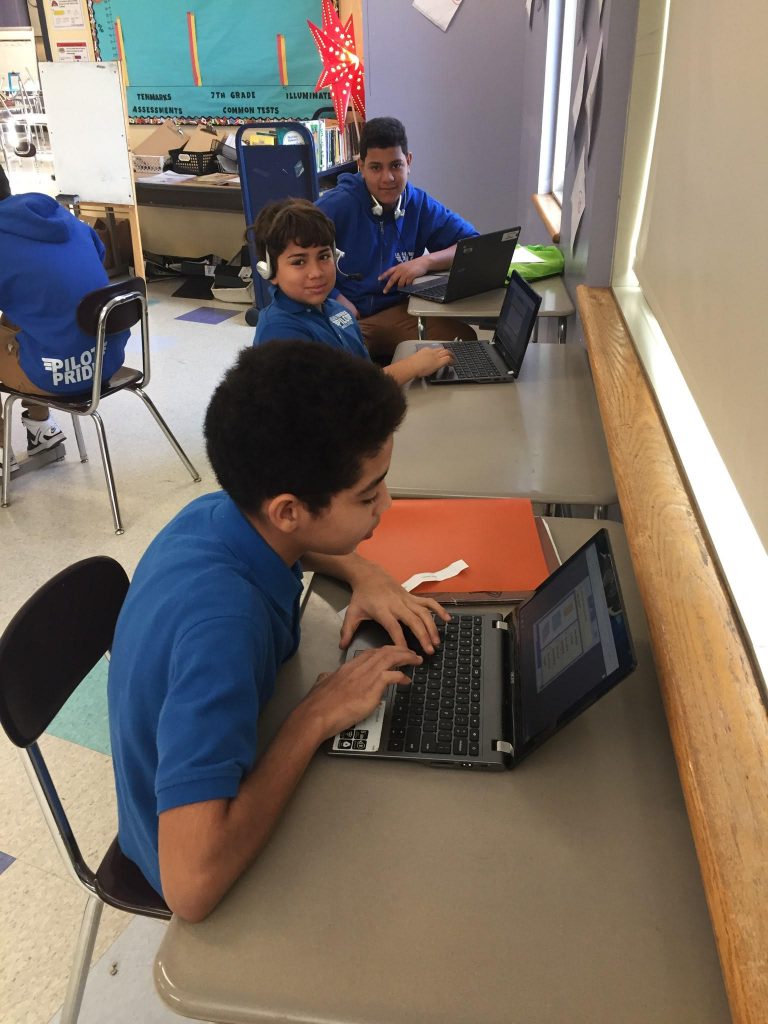Research & Insights / Collaboration & Consistency: Using Technology & Data Analysis Can Support the Growth of our Most Vulnerable Students
Collaboration & Consistency: Using Technology & Data Analysis Can Support the Growth of our Most Vulnerable Students

Christina Kostaras, an SEI 7th grade teacher and Steve Mook, an SEI 8th grade teacher both teach Math and ESL to English Learners at the Lilla G. Frederick Middle School in Dorchester and have been colleagues for the last three years. Their students are new to the country and come with varying levels of math skills. Some are behind on grade-level curriculum while others may be ahead of their grade-level but need support tackling complex math tasks in English. Meeting these diverse needs is a challenge in the classroom, but both Christina and Steve have been extremely successful. On average, their students demonstrated growth of two or more grade levels in one year. Because of this, students who had Christina as a 7th grade teacher and Steve for 8th grade, demonstrated averaged 4 years of growth Christina and Steve decided to reflect together this summer on the reasons behind their success.
Steve: Christina - you wrote the grant proposal to EdVestors Blended Learning Cohort two years ago to utilize blended learning in the math classrooms at the Frederick. What was the impetus behind the proposal? What were you hoping would come out of the grant?
Christina: I wanted to help expand what I had learned from you about incorporating technology and share it with our entire math department. I had also been a Zeroing in on Math Fellow and was really impressed by EdVestors as an organization and wanted to partner with them. I knew that you had already been using blended learning for a number of years, especially Khan Academy - did anything change for you when you started teaching at the Frederick?
Steve: Well, I still use Khan Academy. It is a great platform for assigning both grade-level skills and for more foundational skills, or even for practicing basic math fluency. Depending on the student’s math ability, each student must complete a certain number of skills each quarter; this counts as ? of their grade. With the EdVestors grant, I was able to use the information from the STAR Math diagnostic screening to more precisely create additional groupings during class - I had never had that type of data before. Prior to the STAR assessment there were only two groups: students below grade-level and students at or near grade-level. Now I’m able to create three different groups based on levels of understanding to work together on classwork from Study Island, TenMarks, Khan Academy or sometimes on paper. Also most importantly, all the students are still taught 8th grade standards on top of these interventions.
Steve: You also have different groupings in your class. How did you make your groupings and what results did you see?
Christina: I would say that the most important part of implementing any sort of technology regardless of content area is setting aside the time to look at the program’s data and make a plan for individual students and groups. I’ve found that conferencing with students about their progress on a bi-weekly basis has been a real motivator for students. They enjoy hearing feedback one-on-one from a teacher. Any time we change groupings, students know it’s based on trends in their data. Students spend time in homogeneous and heterogeneous groups based on math skill level or, sometimes on native language depending on the language rigor of the task. Making the grouping process transparent helps mitigate some of the social anxiety students have around how they are perceived in the classroom (which is especially hard to navigate with middle schoolers!) and create an environment where students support each other.
Steve: What do you think has been the secret to our students’ success?
Christina: It’s a combination of being really consistent with the implementation of blended learning and using student data to drive instructional decision making.
Steve: I would add that our collaborative relationship has contributed to our success as well. Our first year working together when we met weekly outside of regular meeting times really set the tone for us being able to discuss student results as well as the nuances and language components of teaching math to English Learners.
Christina: That’s true. It’s helpful that we have been able to collaborate both formally in meetings and informally since you’re right across the hall. Having supportive colleagues in this work is everything. Students thrive when they have a team behind them - can’t wait to see how our students do as they go into high school and beyond!



